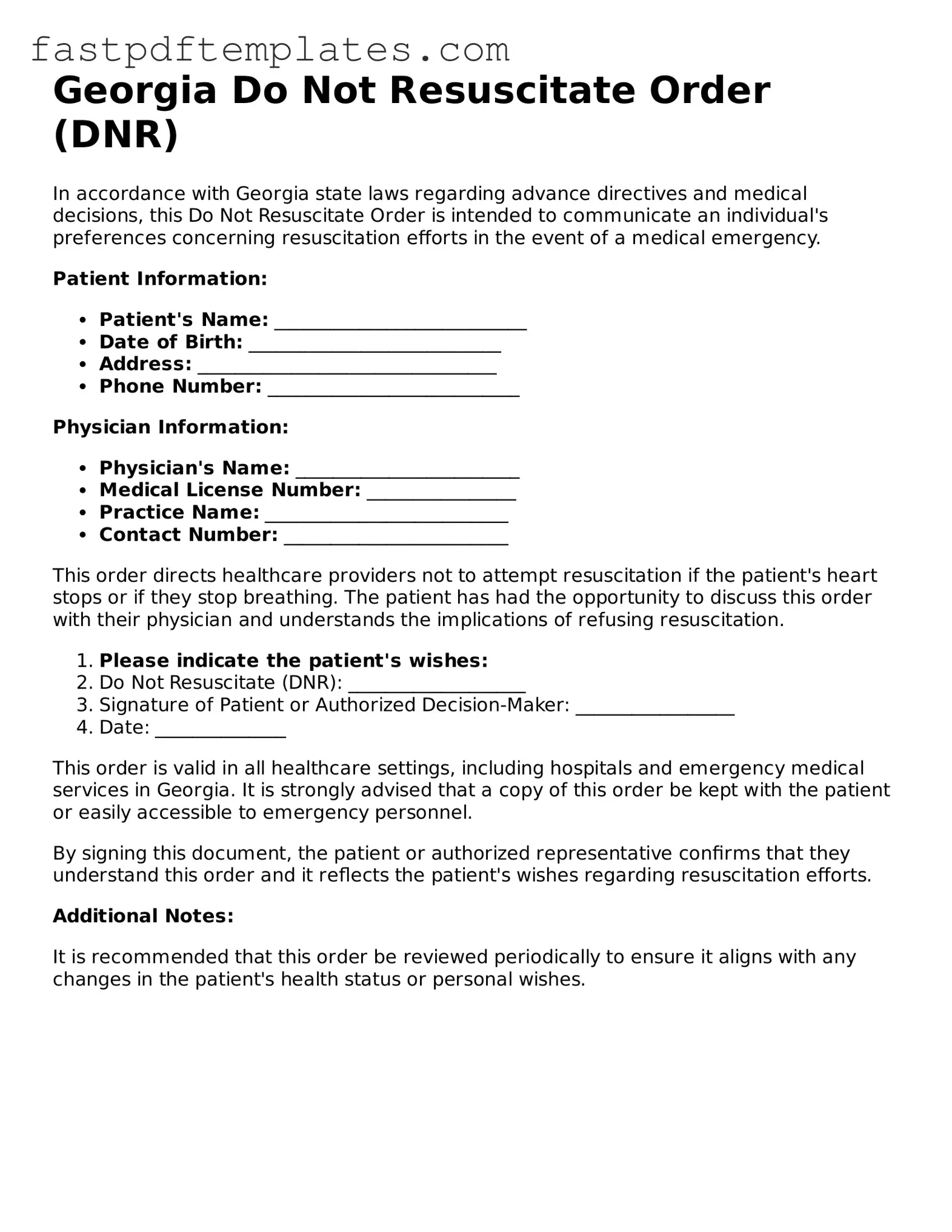The Georgia Do Not Resuscitate (DNR) Order form shares similarities with the Advance Directive for Health Care. Both documents allow individuals to express their medical treatment preferences in advance, particularly concerning life-sustaining measures. While the DNR specifically addresses resuscitation efforts in emergencies, the Advance Directive encompasses a broader range of medical decisions, including the appointment of a healthcare proxy and preferences for other types of medical interventions. This ensures that a person's wishes are respected, even when they cannot communicate them directly.
Another document akin to the DNR is the Physician Orders for Life-Sustaining Treatment (POLST). The POLST form is designed for individuals with serious illnesses and translates their treatment preferences into actionable medical orders. Like the DNR, it provides clear instructions to healthcare providers about the individual’s wishes regarding resuscitation and other life-sustaining treatments. The key difference lies in the POLST’s ability to cover a wider array of medical interventions, ensuring comprehensive care aligned with the patient’s goals.
The Living Will is also comparable to the DNR Order form. This document allows individuals to outline their preferences for end-of-life care in situations where they are unable to express their wishes. While the DNR focuses specifically on resuscitation, the Living Will addresses a broader spectrum of medical treatments, including the use of artificial nutrition and hydration. Both documents serve to guide healthcare providers and family members in making decisions that honor the individual’s values and desires.
The Medical Power of Attorney (MPOA) is another important document that shares characteristics with the DNR Order. The MPOA enables individuals to designate a trusted person to make healthcare decisions on their behalf if they become incapacitated. While the DNR provides specific instructions about resuscitation, the MPOA allows the appointed agent to make decisions based on the individual’s known preferences, ensuring that their wishes regarding resuscitation and other medical interventions are honored.
In addition to these, the Do Not Hospitalize (DNH) order is similar in intent to the DNR. The DNH order is used primarily for patients in long-term care settings who wish to avoid hospitalization for certain conditions. Like the DNR, it reflects the patient’s preferences regarding the level of medical intervention they want in emergencies. Both documents aim to provide clarity and guidance for healthcare providers, ensuring that the individual’s wishes are respected in critical situations.
The Comfort Care Order is another document that aligns with the principles of the DNR Order form. This order prioritizes comfort and quality of life for individuals nearing the end of life, focusing on palliative care rather than aggressive treatments. While the DNR specifically addresses resuscitation efforts, the Comfort Care Order emphasizes the importance of alleviating suffering and providing support during the dying process. Both documents reflect a compassionate approach to healthcare, honoring the individual’s desires in their final days.
The Health Care Proxy is also related to the DNR Order form. This document allows individuals to appoint someone to make healthcare decisions on their behalf if they become unable to do so. While the DNR provides specific instructions regarding resuscitation, the Health Care Proxy empowers the designated individual to interpret and act upon the patient’s wishes in a broader context. Together, these documents ensure that personal values and preferences guide medical care.
The End-of-Life Care Plan is another document that shares similarities with the DNR. This comprehensive plan outlines the individual’s wishes regarding all aspects of care at the end of life, including resuscitation preferences. While the DNR focuses specifically on resuscitation, the End-of-Life Care Plan encompasses a wider range of considerations, such as pain management, emotional support, and spiritual care. Both documents aim to provide a framework for ensuring that healthcare providers respect the individual’s desires during critical moments.
Finally, the Do Not Intubate (DNI) order is closely related to the DNR Order form. The DNI specifies that a patient does not wish to receive intubation or mechanical ventilation in the event of respiratory failure. Similar to the DNR, this document aims to guide healthcare providers in respecting the patient’s wishes during emergencies. Both documents reflect a commitment to honoring individual preferences regarding life-sustaining interventions, ensuring that care aligns with the patient’s values.
